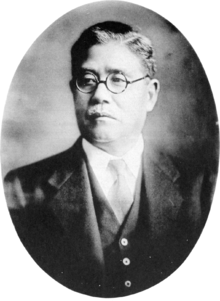Keita Gotō (industrialist)

Keita Gotō (五島慶太, Gotō Keita, 18 April 1882–14 August 1959) was a Japanese businessman who built the Tokyu Group into one of the leading corporate groups in Japan.
Education and civil service career
Gotō was born in 1883 as Keita Kobayashi in the village of Aoki in Nagano Prefecture. After graduating from high school in the nearby city of Matsumoto, he returned to his native village as a grade school teacher. In 1902 he entered what is now the University of Tsukuba, and in 1907 entered the law department of Tokyo Imperial University. After graduating, he entered the Agriculture Ministry at the relatively late age of 29, and three years later transferred to the Ministry of Transport, where he was involved in supervising the national railway system.
In 1912, while still working in the Agriculture Ministry, he married the daughter of an engineer and subsequently assumed her family name, Gotō.
Business career
In 1920, Gotō was offered the post of Director of the Musashi Railway, a struggling company in need of capital to finance its expansion. He accepted and by 1924 had acquired a controlling interest in the company, using the profits from other railway ventures in the Tokyo area. This was the first of many acquisitions in which Gotō bought weak companies and transformed them into profitable members of a growing railway and real estate group. It was also around this time that he persuaded the Tokyo Institute of Technology to relocate along his railway from its former campus, which had been damaged in the 1923 Great Kantō earthquake. Over the next 10 years, this was followed by relocation assistance to several other schools and universities, including the Nippon Medical School and the high school of Tokyo Gakugei University. Together with numerous new residential developments along the railways, this strategy brought steady passengers and increased the value of the company's real estate holdings.
By the time of his death in 1959, his strategy of aggressive acquisitions had built the Tokyu Group into one of Japan's largest corporate empires, with businesses ranging from railways and department stores to hospitals, schools, and leisure and entertainment companies.
Art collection
In his later years, Gotō was a noted collector of Japanese and Asian art. His collection included several National Treasures, including calligraphy, ceramics, and one of the four surviving 13th-century Tale of Genji illustrated handscrolls. The collection is now preserved in the Gotoh Museum in Tokyo.
References
- Sakanishi, Satoru (2001). Management Strategy of Tokyu, Keita Gotō (東急・五島慶太の経営戦略 (Tōkyū, Gotō Keita no keiei senryaku)) (in Japanese). Bungeisha. ISBN 978-4-8355-1142-9.
